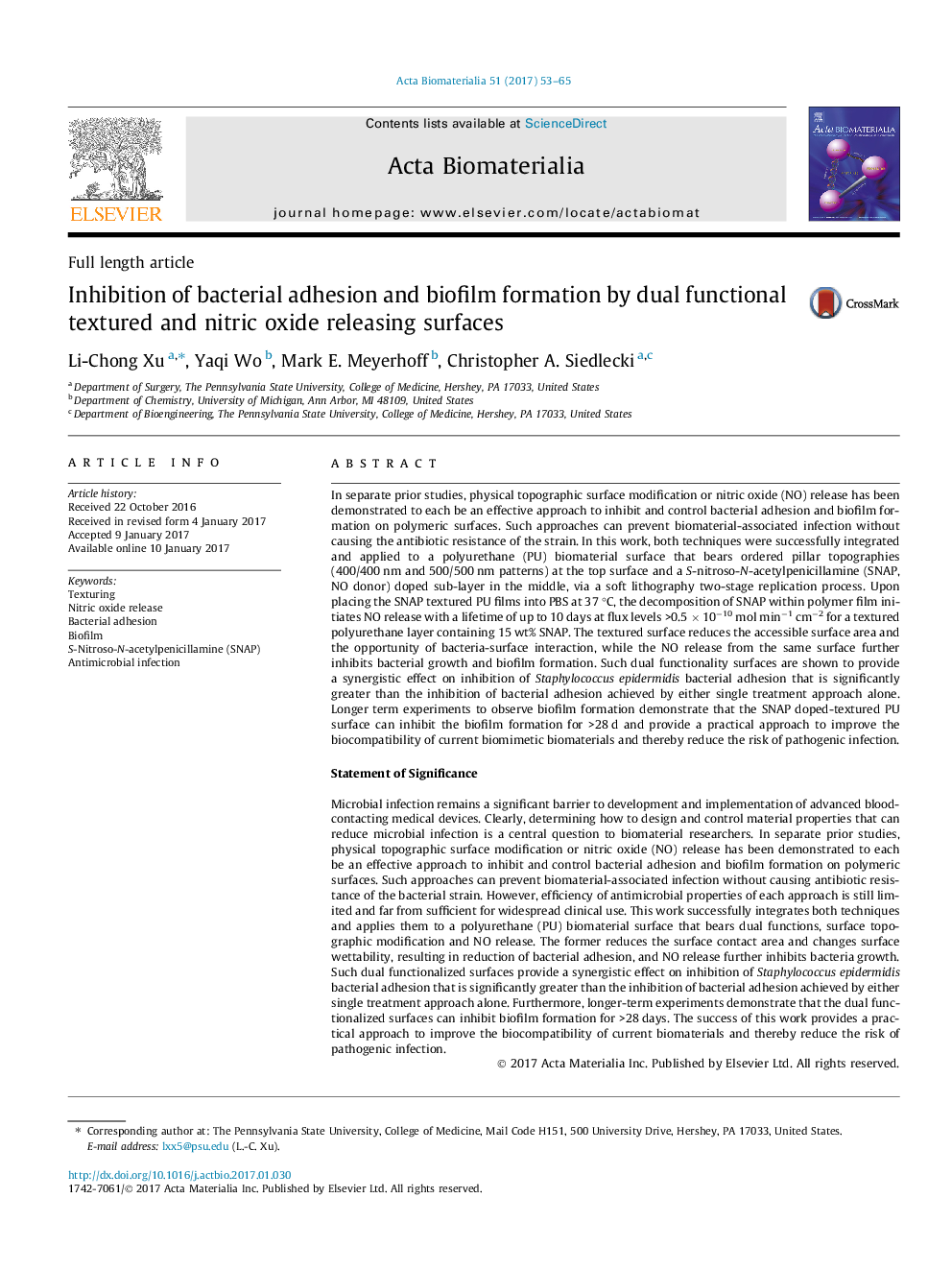| کد مقاله | کد نشریه | سال انتشار | مقاله انگلیسی | نسخه تمام متن |
|---|---|---|---|---|
| 6449462 | 1415935 | 2017 | 13 صفحه PDF | دانلود رایگان |
In separate prior studies, physical topographic surface modification or nitric oxide (NO) release has been demonstrated to each be an effective approach to inhibit and control bacterial adhesion and biofilm formation on polymeric surfaces. Such approaches can prevent biomaterial-associated infection without causing the antibiotic resistance of the strain. In this work, both techniques were successfully integrated and applied to a polyurethane (PU) biomaterial surface that bears ordered pillar topographies (400/400 nm and 500/500 nm patterns) at the top surface and a S-nitroso-N-acetylpenicillamine (SNAP, NO donor) doped sub-layer in the middle, via a soft lithography two-stage replication process. Upon placing the SNAP textured PU films into PBS at 37 °C, the decomposition of SNAP within polymer film initiates NO release with a lifetime of up to 10 days at flux levels >0.5 Ã 10â10 mol minâ1 cmâ2 for a textured polyurethane layer containing 15 wt% SNAP. The textured surface reduces the accessible surface area and the opportunity of bacteria-surface interaction, while the NO release from the same surface further inhibits bacterial growth and biofilm formation. Such dual functionality surfaces are shown to provide a synergistic effect on inhibition of Staphylococcus epidermidis bacterial adhesion that is significantly greater than the inhibition of bacterial adhesion achieved by either single treatment approach alone. Longer term experiments to observe biofilm formation demonstrate that the SNAP doped-textured PU surface can inhibit the biofilm formation for >28 d and provide a practical approach to improve the biocompatibility of current biomimetic biomaterials and thereby reduce the risk of pathogenic infection.Statement of SignificanceMicrobial infection remains a significant barrier to development and implementation of advanced blood-contacting medical devices. Clearly, determining how to design and control material properties that can reduce microbial infection is a central question to biomaterial researchers. In separate prior studies, physical topographic surface modification or nitric oxide (NO) release has been demonstrated to each be an effective approach to inhibit and control bacterial adhesion and biofilm formation on polymeric surfaces. Such approaches can prevent biomaterial-associated infection without causing antibiotic resistance of the bacterial strain. However, efficiency of antimicrobial properties of each approach is still limited and far from sufficient for widespread clinical use. This work successfully integrates both techniques and applies them to a polyurethane (PU) biomaterial surface that bears dual functions, surface topographic modification and NO release. The former reduces the surface contact area and changes surface wettability, resulting in reduction of bacterial adhesion, and NO release further inhibits bacteria growth. Such dual functionalized surfaces provide a synergistic effect on inhibition of Staphylococcus epidermidis bacterial adhesion that is significantly greater than the inhibition of bacterial adhesion achieved by either single treatment approach alone. Furthermore, longer-term experiments demonstrate that the dual functionalized surfaces can inhibit biofilm formation for >28 days. The success of this work provides a practical approach to improve the biocompatibility of current biomaterials and thereby reduce the risk of pathogenic infection.
86
Journal: Acta Biomaterialia - Volume 51, 15 March 2017, Pages 53-65
